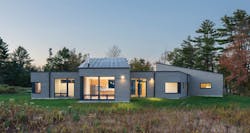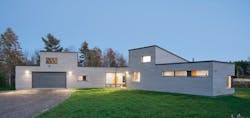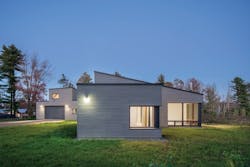Custom Prefabrication: Weather Proof
Alan Gibson, principal of Belfast, Maine-based design/build firm GO Logic, studied prefabrication in Sweden and came to find he preferred the panelization approach over modular prefab. Gibson believes panelization provides more design flexibility—at least when not limited by what size box can be trucked to a site.
“The learning curve was all about getting design decisions made and architectural drawings translated into detailed shop drawings before cutting your first stick of wood,” he says. “It’s similar to custom cabinetry but much more complicated.”
The home’s exterior cladding is cedar board with texture milled into the finish.
Using prefab components also helps the firm reach its Passive House goals with economies of scale for construction elements such as windows and flashing, the installation of which can be perfected on a factory floor more easily than on a ladder on site exposed to the elements. Still, Gibson admits prefab requires a different mentality.
“It’s more of a manufacturing approach,” he explains. “We focus on producing a certain number of square feet of wall assembly in a day. Right now, we’re into the process of dividing up labor and studying drawings so we can build panels more efficiently.”
For this custom home sited on what Gibson describes as a “damp hayfield,” prefab construction was the only option given the timing and client needs. The clients, a couple moving closer to their adult children, wanted this second home—intended to eventually become their full-time residence—to include storage for their more than 30-foot-long double rowing scull.
Building a home with oversized windows to Passive House standards required balancing heat loss with solar gain from the glass, along with super insulation. Walls are R-50, the ceiling is R-85, and the slab is R-35.
“The long garage was a starting point, which we connected via mudroom to the single-story house,” Gibson says. “It’s a simple plan with a central open living, kitchen, dining space, and then just two bedrooms on opposite ends of the public areas. There is a lot of glass, so we panelized the walls before we got the window package—not the way we normally do it—and installed these expanses of glass on-site. It did help us work through issues in the shop and spend less time on the jobsite.”
Those big windows also required additional structural work and engineered wood beams running through the kitchen. This meant thicker walls to accommodate the beams as well as plumbing and wiring. Heat loss from the large glass openings is mitigated by placing many of the windows on the home’s southern elevation for solar gain.
RELATED
- Custom Prefabrication: Urban Sensation
- Custom Prefabrication: High End from Factory to the Bay
- Backstory: Out-of-the-Box Thinking From the Factory
Electric appliances and a condensing dryer eliminate the need for extraneous holes in the building envelope, so air leakage is minimized and the house is tighter.
The single-story plan the clients wanted meant considering interior sight lines from various vantage points. Finishes fit the straightforward layout and clean lines with polished concrete floors, white painted drywall interiors, and gray textured cedar board cladding on the exterior.
Project: Kemper House
Designer / Builder: GO Logic, Belfast, Maine
Structural engineer: Albert Putnam Associates, Brunswick, Maine
Photos: Josh Gerritsen Media
Shelley D. Hutchins writes about residential construction, design, and sustainable building.


